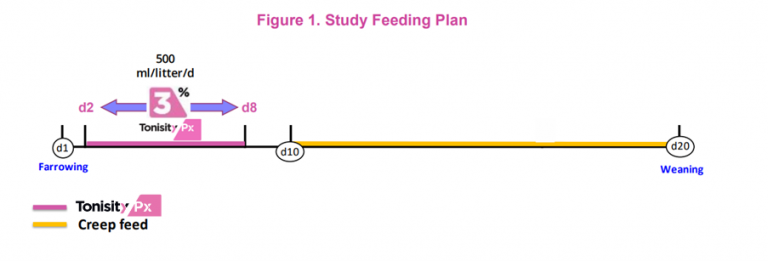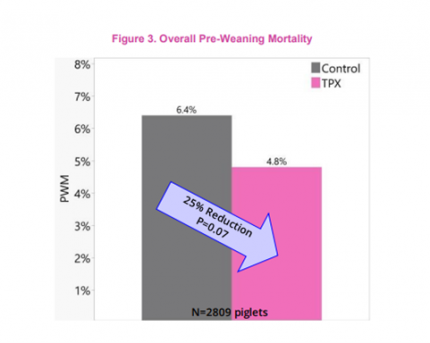
Tonisity recently carried out a study on a 4,000-sow commercial farm in Chile. The objective of this research was to evaluate the effect on piglet pre-weaning mortality (PWM) of Tonisity Px (TPX), a combination of electrolytes and key gut enhancing bioactives, in the farrowing house. Historically, the farm produces 2.3 litters per sow per year, with an average 15 piglets born alive per litter, which translates to 138,000 piglets per year with PWM usually occurring at a rate of 9.8%. Both groups (TPX and control) were well balanced for parity and litter size indicating a well-managed study.
In summary, feeding Tonisity Px from days two to eight of life resulted in:
Better survival – 25% lower PWM overall
40% lower PWM in parity three to six litters
15% lower PWM in parity one to two litters
Better vitality – 33% fewer crushed piglets
Tonisity Px fed to all piglets from day two to eight of life resulted in an extra 0.55 piglets per sow per year, which translates to 2,200 extra piglets a year across this one site!
Study feeding plan

Tonisity Px piglets received (Figure 1) 500ml per litter per day of a 3% Tonisity Px solution between days two and eight of life (with farrowing day being considered day one)
Control piglets did not receive any additional supplementation between days two and eight
Both groups received dry creep feed from day 10 to weaning (day 20).
In both groups, AcidWean (vitamins, electrolytes, sweetener and acidifier) was provided, pens were given 500ml per litter per day for the entire pre-weaning period for runt litters and for five to seven days for litters suffering with diarrhea, regardless of the treatment group. Tonisity Px and AcidWean were administered in separate round creep feed pans.
The water used for Tonisity Px reconstitution was filtered using a HydroLife 300 filter to ensure optimal microbiological and chemical quality.
Data collection
Pre-weaning mortality (PWM) – study records included
The number of dead piglets by litter
Mortality rate
The apparent cause of death (crushing, diarrhea, euthanasia or starvation)
Pre-Weaning Mortality
The mortality in this study was low when compared to the 13.2% worldwide average reported by the InterPIG Consortium, which indicates a good farrowing house management. The overall mortality in the TPX group was 1.6% lower than the Control group, representing a 25% reduction with a P value of 0.07 (Figure 3). This results in an extra 0.24 piglets per litter, and an extra 16 piglets for every 1,000 born. The current study results agree with our global mortality meta-analysis which included 148,170 pigs in 12,442 litters carried out in 22 countries over the last seven years. In these studies, the average mortality in TPX groups is 9.5% in comparison to that of Control groups, which is 11.8%. This represents a very significant 20% reduction in the TPX groups.

Mortality by parity
In this study, we investigated whether TPX had a preferential effect on litters of young vs. older sows. To achieve this, the data was reanalysed, and litters were categorised based on sow parity into parity 1-2, parity 3-6 and parity 7. The Tonisity Px effect was most significant in parity 3-6 sows. The PWM for TPX piglets in this groups represented a 40% reduction with a P value of 0.02.
This would result in an extra 0.48 piglets per litter, and an extra 32 piglets for every 1,000 born!
Mortality by cause of death
The main cause of death for the piglets in this study was crushing, followed by starvation and then diarrhea and euthanasia respectively. It is significant to note that PWM, as a result of crushing, for the TPX group showed a 33% reduction with a P value of 0.03.
Recommendations
Tonisity Px should be administered to all piglets in all litters
To ensure optimum Tonisity Px consumption:
Tonisity Px solution should be reconstituted daily
Feeding pans should be cleaned, especially for litters prone to diarrhea
Feeding pans should be correctly positioned, to ensure piglet do not soil the Tonisity Px solution, and so that all piglets have access to the solution without having to go around the sow
The feeding pans should be checked for leaks
To ensure optimal weaning weights and a smooth weaning transition, it is recommended to administer Tonisity Px for three days pre-weaning on top of creep feed. There has been great success when administering Tonisity Px in small amounts as a top-dressing at day 9 to 10 to 11, when creep feed is first introduced.
Both strategies help improve creep feed consumption and prepare the pig for the transition to a solid feed diet.

